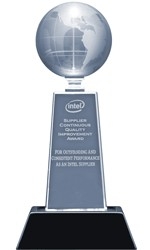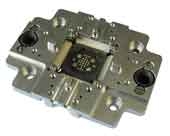April 20, 2011 – Intel has handed out its annual supplier awards, this year to 28 companies, including some one-time "Achievement" awards for particular impact.
To earn Intel’s "Supplier Continuous Quality Improvement" (SCQI) award — now in its 24th year — eight companies (vs. 10 honorees in 2009 and 16 in 2008) scored at least 95% on a list of performance and ability goals, including cost, quality, availability, delivery, technology and environmental/social/governance, over the past year. They also achieved ≥90% on an improvement plan and "demonstrated solid quality and business systems."
Another 20 suppliers (vs. 16 in 2009 and 26 in 2008) scored 80% or better to earn Intel’s 2010 "Preferred Quality Supplier" (PQS) recognition. Criteria include "consistently exceed[ing]" Intel expectations, aligning to technology and manufacturing roadmaps, meeting cost reduction goals, and delivering excellent "customer satisfaction." And this year, four suppliers were picked for an "Achievement Award," billed as a "one-time extraordinary achievement" that has "enabled significant business impact to Intel across the areas of cost, quality, availability, technology, sustainability and customer satisfaction."
"Our industry is experiencing significant changes that make it even more important to partner with outstanding suppliers to deliver leading-edge technology to our customers," noted said William Holt, SVP/GM of Intel’s Technology and Manufacturing Group, in a statement. "Continuous improvement is what differentiates good companies from great companies," added Brian Krzanich, SVP/GM of Intel’s Manufacturing and Supply Chain, and the eight SCQI winners excelled in "innovation, agility, customer responsiveness, and environmental sustainability."
More facts about this year’s inductees:
- Disco, Hitachi High-Tech, Hitachi Kokusai, Senju, and Sumco are all threepeat SCQI winners. Fujifilm and Rofin-Baasel are three-time PQS winners.
- TEL was the only supplier to climb up from last year’s PQS ranks into SCQI status.
- Falling off last year’s SCQI list from a year ago: Daewon Semiconductor Packaging (now PQS status), DEK, Moses Lake/Tama Chemicals (also PQS status), Munters, and Verizon.
- Gone from the PQS list: AceCo, ASE, Cisco, Nippon Mining & Metals, Nordson ASYMTEK, and Praxair Electronics. Grohmann and Hirata were PQS winners in 2009 but took home this year’s inaugural "achievement award."
- Note that ASML and Nikon are both are still among Intel’s most recognized suppliers. Nikon used to be the incumbent litho tool supplier (and SCQI winner in 2008), but Intel is known to be splitting its litho business now with ASML — and with both suppliers recognized for a second year in a row, that plan seems to be working well.
Intel launched the SCQI program in 1987 to improve the systems and output of key suppliers, and minimize its time and money spent inspecting incoming material, goods, and services purchased. The company honored 26 companies in 2009, 40 in 2008, 48 in 2007, 54 in 2006, 38 in 2005, 43 in 2004, 45 in 2003, and 42 in 2002. (Note the trend of fewer companies being honored; the company didn’t say whether this is attributable to its own criteria, or to marketplace dynamics.)
The 2010 SCQI winners are:
* Disco (blade dicing and laser saws, wafer thinning, and polishing equipment)
* Hitachi High-Technologies (etching systems, FE-SEMs, CD-SEM, defect inspection tools)
* Hitachi Kokusai Electric (diffusion furnaces)
JSR (photoresists, packaging materials, and CMP consumables)
* Senju Metal Industry (electronic interconnect materials)
Shinko Electric Industries (plastic laminated packages and heat spreaders)
* SUMCO (200mm and 300mm polished and test silicon wafers)
** Tokyo Electron (semiconductor production equipment)
Winners of the 2010 PQS award include:
** ASML (lithography process tools)
** Cabot Microelectronics (CMP slurries)
* Daewon Semiconductor Packaging (handling media)
** Daifuku (fab automated material handling systems)
Dai Nippon Printing (advanced photomasks)
** Fujifilm Electronic Materials (chemistry, equipment for semiconductor device manufacturing)
Mitsubishi Gas Chemical (chemicals for semiconductor device manufacturing)
* Moses Lake Industries/TAMA Chemicals (ultrahigh-purity chemicals)
Murata Manufacturing (multilayer ceramic capacitors, inductors, and interference components)
** Nikon (lithography scanners and steppers)
** Rofin-Baasel (laser mark equipment)
Siltronic (polished and epitaxial silicon wafers)
STATS ChipPAC (turnkey packaging and test services)
Taiyo Yuden (multilayer ceramic capacitors, inductors, electromagnetic interference components)
TSMC (foundry services)
And the four suppliers named for one-time "achievement award" are:
Advantest (test equipment), for "velocity and availability"
Gemteck Technology (wireless products), for "customer satisfaction"
** Grohmann Engineering (assembly equipment), for "affordability"
** Hirata (automation equipment), for "breakthrough technology"
(* a 2009 SQCI winner)
(** a 2009 PQS winner)





 The customer was able to run a high-volume application with more than 100k throughput per day at an octal-site set up for more than 1.5 years without contactor-wear related
The customer was able to run a high-volume application with more than 100k throughput per day at an octal-site set up for more than 1.5 years without contactor-wear related